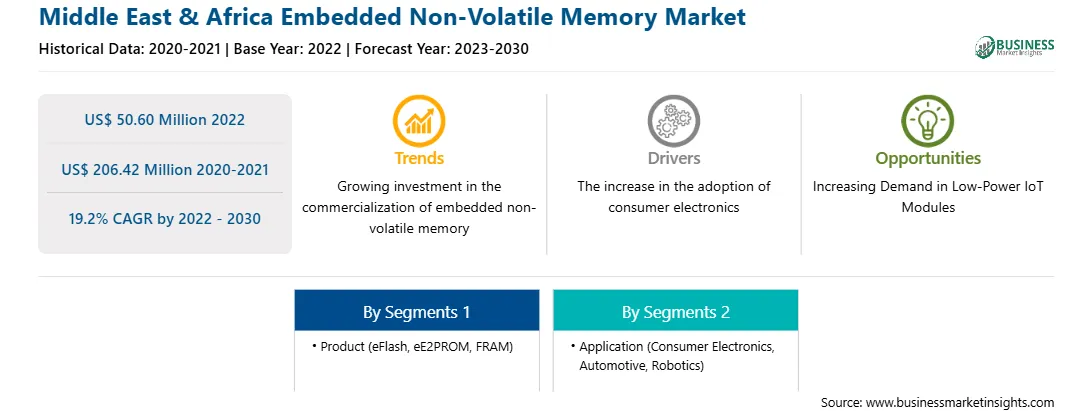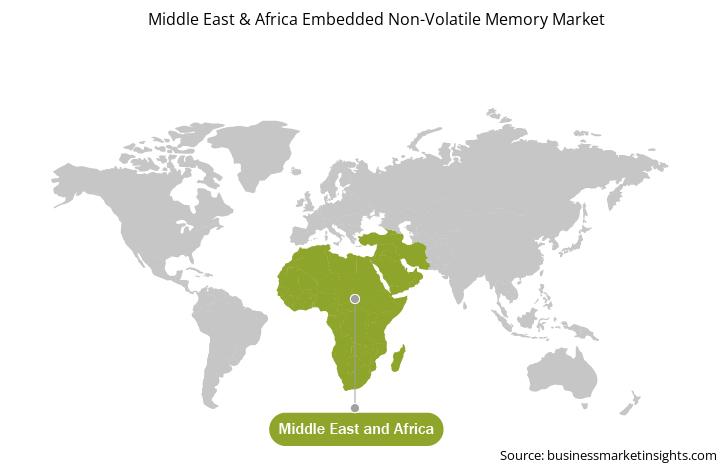中东和非洲嵌入式非易失性存储器市场预测至 2028 年 - 按类型(eFlash、eOTP、eE2PROM、eMTP、eMRAM 等)和行业(消费产品、汽车、IT 和通信等)划分的 COVID-19 影响和区域分析其他的)
No. of Pages: 69 | Report Code: TIPRE00027067 | Category: Electronics and Semiconductor
No. of Pages: 69 | Report Code: TIPRE00027067 | Category: Electronics and Semiconductor
内存市场,其早期发展20 世纪初,随着手机、DSC 和 MP3 播放器等数字消费和移动市场的兴起,这种技术始于 20 世纪 70 年代和 80 年代的 PC 和服务器 DRAM,并得到了新的推动。非易失性和低功耗闪存的结合带来了更快速的扩展。随着密度的增加和费用的减少,消费者的需求急剧增加。存储技术中高密度、高速、低功耗技术的不断进步体现在设计规则上,呈现出从微米级到纳米级可扩展性的转变。此外,由于新材料的发展,新型高性能非易失性存储器(PRAM、RRAM、MRAM、FRAM等)的出现,为半导体市场的增长提供了更大的潜力。在最新的存储技术中,供每个人使用的存储信息的容量和速度已显着提高:1 sg cm 的存储芯片现在可以容纳 10Gbit 信息,相当于 80K 页的报纸、20 小时的音乐或 2.5 小时的电影。如今,DRAM 的随机存取时间为 25–50ns,I/O 带宽为 3–4GHz。由于技术进步,未来内存密度和速度将继续提高。 3D 内存堆叠技术(单元/芯片/封装)、3 维晶体管的使用或内存存储节点缩小到原子尺寸等突破预计将带来更高的存储密度。传统商品存储器和新型存储器的融合可以提高存储系统的性能。因此,半导体产品将提供更广泛的高性能系统,并显着提高耐用性和持久性。二十一世纪内存技术将与其他多个领域(IT、BT、NT)融合,开辟海量数据与信息处理、生物与医疗保健、人形与飞行器等新市场。
中东和非洲地区面临 COVID-19 经济后果的主要国家是沙特阿拉伯、阿联酋、埃及、摩洛哥和科威特。随着新冠肺炎 (COVID-19) 大流行在上述国家蔓延,越来越明显的是,几乎没有什么国家能够逃脱其影响,这给所有部门带来了重大挑战。 2020年初,中东地区的制造业因疫情爆发而受到严重影响。然而,为了应对巨大的经济影响,阿联酋等国家已采取必要措施继续该地区的经济活动。因此,阿联酋政府正在推动各行业采用先进技术,以提高效率。因此,该地区为降低冠状病毒对制造业的影响而采取的越来越多的举措将确保多年来嵌入式非易失性存储器市场受到中等到低的影响。
< /p>
借助新功能和技术,供应商可以吸引新客户并扩大其在新兴市场的足迹。这一因素可能会推动嵌入式非易失性存储器市场的发展。 MEA 嵌入式非易失性存储器市场预计在预测期内将以良好的复合年增长率增长。
Strategic insights for Middle East & Africa Embedded Non-Volatile Memory involve closely monitoring industry trends, consumer behaviours, and competitor actions to identify opportunities for growth. By leveraging data analytics, businesses can anticipate market shifts and make informed decisions that align with evolving customer needs. Understanding these dynamics helps companies adjust their strategies proactively, enhance customer engagement, and strengthen their competitive edge. Building strong relationships with stakeholders and staying agile in response to changes ensures long-term success in any market.

| Report Attribute | Details |
|---|---|
| Market size in 2022 | US$ 50.60 Million |
| Market Size by 2030 | US$ 206.42 Million |
| Global CAGR (2022 - 2030) | 19.2% |
| Historical Data | 2020-2021 |
| Forecast period | 2023-2030 |
| Segments Covered |
By 产品
|
| Regions and Countries Covered | 中东和非洲
|
| Market leaders and key company profiles |
The regional scope of Middle East & Africa Embedded Non-Volatile Memory refers to the geographical area in which a business operates and competes. Understanding regional nuances, such as local consumer preferences, economic conditions, and regulatory environments, is crucial for tailoring strategies to specific markets. Businesses can expand their reach by identifying underserved regions or adapting their offerings to meet regional demands. A clear regional focus allows for more effective resource allocation, targeted marketing, and better positioning against local competitors, ultimately driving growth in those specific areas.

The Middle East & Africa Embedded Non-Volatile Memory Market is valued at US$ 50.60 Million in 2022, it is projected to reach US$ 206.42 Million by 2030.
As per our report Middle East & Africa Embedded Non-Volatile Memory Market, the market size is valued at US$ 50.60 Million in 2022, projecting it to reach US$ 206.42 Million by 2030. This translates to a CAGR of approximately 19.2% during the forecast period.
The Middle East & Africa Embedded Non-Volatile Memory Market report typically cover these key segments-
The historic period, base year, and forecast period can vary slightly depending on the specific market research report. However, for the Middle East & Africa Embedded Non-Volatile Memory Market report:
The Middle East & Africa Embedded Non-Volatile Memory Market is populated by several key players, each contributing to its growth and innovation. Some of the major players include:
The Middle East & Africa Embedded Non-Volatile Memory Market report is valuable for diverse stakeholders, including:
Essentially, anyone involved in or considering involvement in the Middle East & Africa Embedded Non-Volatile Memory Market value chain can benefit from the information contained in a comprehensive market report.